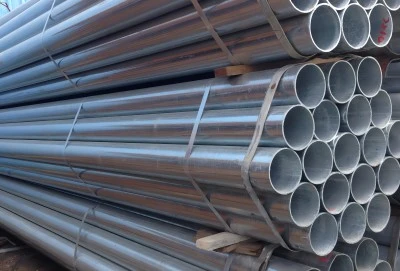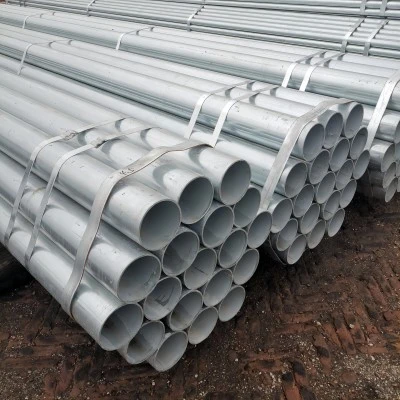When it comes to selecting the right piping material for your project, the choice between ASTM A53 galvanized pipe and black pipe can significantly impact your system's performance and longevity. Galvanized pipe, known for its distinctive zinc coating, offers enhanced corrosion resistance and durability in various applications. On the other hand, black pipe, with its raw steel surface, presents its own set of advantages in certain environments. This comprehensive guide will help you navigate the key differences, applications, and maintenance considerations of these two popular piping options, ensuring you make an informed decision for your specific needs.
|
|
|
Durability Showdown: Galvanized vs. Black Pipe
Corrosion Resistance: A53 Galvanized Pipe's Edge
A53 galvanized pipe stands out in corrosion resistance, thanks to its protective zinc coating. This layer acts as a sacrificial barrier, corroding before the underlying steel and significantly extending the pipe's lifespan. In coastal areas or industrial settings where corrosive elements are prevalent, galvanized pipes prove invaluable. The zinc coating also provides a uniform, smooth surface that resists buildup and ensures consistent flow rates over time.
Weathering the Elements: Black Pipe's Performance
While black pipe lacks the protective zinc layer of its galvanized counterpart, it still offers reliable performance in certain conditions. In indoor applications or environments with low humidity, black pipe can maintain its integrity for extended periods. However, when exposed to moisture or corrosive substances, it's prone to rust formation. This vulnerability necessitates additional protective measures or regular maintenance to ensure longevity.
Longevity Comparison: Which Pipe Lasts Longer?
In terms of overall lifespan, A53 galvanized pipe typically outlasts black pipe, especially in challenging environments. The zinc coating can add decades to the pipe's service life, reducing the need for replacements and associated downtime. Black pipe, while initially more cost-effective, may require more frequent replacements or repairs in corrosive settings. However, in controlled indoor environments or with proper maintenance, black pipe can also offer substantial longevity.
Application Guide: Choosing Between A53 Options
Indoor vs. Outdoor: Selecting the Right A53 PipeThe choice between galvanized and black A53 pipe often hinges on the installation environment. For outdoor applications, particularly in humid or coastal areas, galvanized pipe is the preferred choice. Its corrosion-resistant properties make it ideal for exposed pipelines, outdoor plumbing, and structures subject to weather elements. Indoor applications, especially in climate-controlled spaces, can often utilize black pipe effectively, as the risk of corrosion is significantly reduced.
Industry-Specific A53 Pipe Requirements
Different industries have varying requirements for piping materials. In the oil and gas sector, both galvanized and black pipes find applications, with the choice depending on the specific part of the process and environmental conditions. Water supply systems often favor galvanized pipes for their corrosion resistance and ability to maintain water quality. Bridge and building structures may use either type, depending on exposure levels and local building codes. Offshore platforms typically opt for galvanized pipes to withstand the harsh marine environment.
Cost-Efficiency: Balancing Price and Performance
While galvanized pipe initially comes at a higher cost than black pipe, its long-term value often justifies the investment. The extended lifespan and reduced maintenance needs of galvanized pipes can result in lower total ownership costs over time. Black pipe, being less expensive upfront, may be more suitable for projects with tight budgets or in applications where corrosion is less of a concern. A thorough cost-benefit analysis, considering factors like installation environment, expected lifespan, and maintenance requirements, is crucial in making the most cost-effective choice.
Maintenance Comparison: Long-Term Considerations
Galvanized A53 Pipe: Minimal Upkeep StrategiesOne of the primary advantages of galvanized A53 pipe is its low maintenance requirements. The zinc coating provides a self-healing property, where minor scratches or abrasions are protected by the surrounding zinc. Regular inspections are still recommended to check for any signs of coating degradation or physical damage. In most cases, maintenance is limited to occasional cleaning to remove any accumulated debris or contaminants that could potentially trap moisture against the pipe surface.
Black A53 Pipe: Preventing Rust and Deterioration
Black pipe requires more vigilant maintenance to prevent rust and deterioration. In exposed applications, regular inspections for rust formation are crucial. Applying protective coatings or paints can significantly extend the pipe's lifespan. In industrial settings, implementing cathodic protection systems might be necessary to mitigate corrosion risks. Prompt addressing of any rust spots or damage is essential to prevent the spread of corrosion.
Lifecycle Costs: A53 Galvanized vs. Black Pipe
When considering lifecycle costs, galvanized A53 pipe often emerges as the more economical choice in the long run, especially in corrosive environments. Its higher upfront cost is offset by reduced maintenance expenses and longer service life. Black pipe, while cheaper initially, may incur higher costs over time due to more frequent replacements or repairs. However, in controlled environments with proper maintenance, black pipe can also offer cost-effective performance. The final decision should factor in installation location, expected lifespan, and specific project requirements.
Choosing between ASTM A53 galvanized pipe and black pipe requires careful consideration of your project's specific needs. Galvanized pipe excels in corrosion resistance and longevity, making it ideal for outdoor and harsh environments. Black pipe offers cost-effective solutions for indoor and less corrosive settings. By weighing factors such as installation environment, industry requirements, and long-term maintenance needs, you can make an informed decision that ensures optimal performance and cost-efficiency for your piping system. Remember, the right choice depends on your unique project parameters and long-term operational goals.
ASTM A53 Pipes Supplier
For high-quality ASTM A53 pipes, Hebei Longma Group stands out as a reliable supplier. With advanced production equipment imported from Germany and independently developed technologies, Longma ensures top-notch product quality. Their professional team of over 300 employees, including 60+ technical experts, guarantees expert support and innovative solutions. Comprehensive testing facilities, including ultrasonic flaw detectors and X-ray equipment, ensure product integrity. Longma offers fast delivery, with standard thickness pipes ready in as little as 7 days. They provide complete certifications, including API 5L and ISO 9001, meeting global standards. Thanks to stable raw material partnerships and efficient production, Longma offers competitive pricing without compromising quality. For A53 galvanized pipe and other piping needs, contact us at info@longma-group.com.














